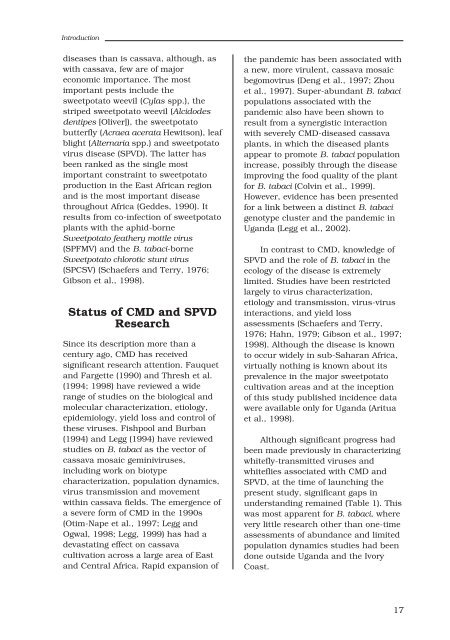Whitefly and whitefly-borne viruses in the tropics : Building a ... - cgiar
Whitefly and whitefly-borne viruses in the tropics : Building a ... - cgiar
Whitefly and whitefly-borne viruses in the tropics : Building a ... - cgiar
You also want an ePaper? Increase the reach of your titles
YUMPU automatically turns print PDFs into web optimized ePapers that Google loves.
Introduction<br />
diseases than is cassava, although, as<br />
with cassava, few are of major<br />
economic importance. The most<br />
important pests <strong>in</strong>clude <strong>the</strong><br />
sweetpotato weevil (Cylas spp.), <strong>the</strong><br />
striped sweetpotato weevil (Alcidodes<br />
dentipes [Oliver]), <strong>the</strong> sweetpotato<br />
butterfly (Acraea acerata Hewitson), leaf<br />
blight (Alternaria spp.) <strong>and</strong> sweetpotato<br />
virus disease (SPVD). The latter has<br />
been ranked as <strong>the</strong> s<strong>in</strong>gle most<br />
important constra<strong>in</strong>t to sweetpotato<br />
production <strong>in</strong> <strong>the</strong> East African region<br />
<strong>and</strong> is <strong>the</strong> most important disease<br />
throughout Africa (Geddes, 1990). It<br />
results from co-<strong>in</strong>fection of sweetpotato<br />
plants with <strong>the</strong> aphid-<strong>borne</strong><br />
Sweetpotato fea<strong>the</strong>ry mottle virus<br />
(SPFMV) <strong>and</strong> <strong>the</strong> B. tabaci-<strong>borne</strong><br />
Sweetpotato chlorotic stunt virus<br />
(SPCSV) (Schaefers <strong>and</strong> Terry, 1976;<br />
Gibson et al., 1998).<br />
Status of CMD <strong>and</strong> SPVD<br />
Research<br />
S<strong>in</strong>ce its description more than a<br />
century ago, CMD has received<br />
significant research attention. Fauquet<br />
<strong>and</strong> Fargette (1990) <strong>and</strong> Thresh et al.<br />
(1994; 1998) have reviewed a wide<br />
range of studies on <strong>the</strong> biological <strong>and</strong><br />
molecular characterization, etiology,<br />
epidemiology, yield loss <strong>and</strong> control of<br />
<strong>the</strong>se <strong>viruses</strong>. Fishpool <strong>and</strong> Burban<br />
(1994) <strong>and</strong> Legg (1994) have reviewed<br />
studies on B. tabaci as <strong>the</strong> vector of<br />
cassava mosaic gem<strong>in</strong>i<strong>viruses</strong>,<br />
<strong>in</strong>clud<strong>in</strong>g work on biotype<br />
characterization, population dynamics,<br />
virus transmission <strong>and</strong> movement<br />
with<strong>in</strong> cassava fields. The emergence of<br />
a severe form of CMD <strong>in</strong> <strong>the</strong> 1990s<br />
(Otim-Nape et al., 1997; Legg <strong>and</strong><br />
Ogwal, 1998; Legg, 1999) has had a<br />
devastat<strong>in</strong>g effect on cassava<br />
cultivation across a large area of East<br />
<strong>and</strong> Central Africa. Rapid expansion of<br />
<strong>the</strong> p<strong>and</strong>emic has been associated with<br />
a new, more virulent, cassava mosaic<br />
begomovirus (Deng et al., 1997; Zhou<br />
et al., 1997). Super-abundant B. tabaci<br />
populations associated with <strong>the</strong><br />
p<strong>and</strong>emic also have been shown to<br />
result from a synergistic <strong>in</strong>teraction<br />
with severely CMD-diseased cassava<br />
plants, <strong>in</strong> which <strong>the</strong> diseased plants<br />
appear to promote B. tabaci population<br />
<strong>in</strong>crease, possibly through <strong>the</strong> disease<br />
improv<strong>in</strong>g <strong>the</strong> food quality of <strong>the</strong> plant<br />
for B. tabaci (Colv<strong>in</strong> et al., 1999).<br />
However, evidence has been presented<br />
for a l<strong>in</strong>k between a dist<strong>in</strong>ct B. tabaci<br />
genotype cluster <strong>and</strong> <strong>the</strong> p<strong>and</strong>emic <strong>in</strong><br />
Ug<strong>and</strong>a (Legg et al., 2002).<br />
In contrast to CMD, knowledge of<br />
SPVD <strong>and</strong> <strong>the</strong> role of B. tabaci <strong>in</strong> <strong>the</strong><br />
ecology of <strong>the</strong> disease is extremely<br />
limited. Studies have been restricted<br />
largely to virus characterization,<br />
etiology <strong>and</strong> transmission, virus-virus<br />
<strong>in</strong>teractions, <strong>and</strong> yield loss<br />
assessments (Schaefers <strong>and</strong> Terry,<br />
1976; Hahn, 1979; Gibson et al., 1997;<br />
1998). Although <strong>the</strong> disease is known<br />
to occur widely <strong>in</strong> sub-Saharan Africa,<br />
virtually noth<strong>in</strong>g is known about its<br />
prevalence <strong>in</strong> <strong>the</strong> major sweetpotato<br />
cultivation areas <strong>and</strong> at <strong>the</strong> <strong>in</strong>ception<br />
of this study published <strong>in</strong>cidence data<br />
were available only for Ug<strong>and</strong>a (Aritua<br />
et al., 1998).<br />
Although significant progress had<br />
been made previously <strong>in</strong> characteriz<strong>in</strong>g<br />
<strong>whitefly</strong>-transmitted <strong>viruses</strong> <strong>and</strong><br />
whiteflies associated with CMD <strong>and</strong><br />
SPVD, at <strong>the</strong> time of launch<strong>in</strong>g <strong>the</strong><br />
present study, significant gaps <strong>in</strong><br />
underst<strong>and</strong><strong>in</strong>g rema<strong>in</strong>ed (Table 1). This<br />
was most apparent for B. tabaci, where<br />
very little research o<strong>the</strong>r than one-time<br />
assessments of abundance <strong>and</strong> limited<br />
population dynamics studies had been<br />
done outside Ug<strong>and</strong>a <strong>and</strong> <strong>the</strong> Ivory<br />
Coast.<br />
17
















